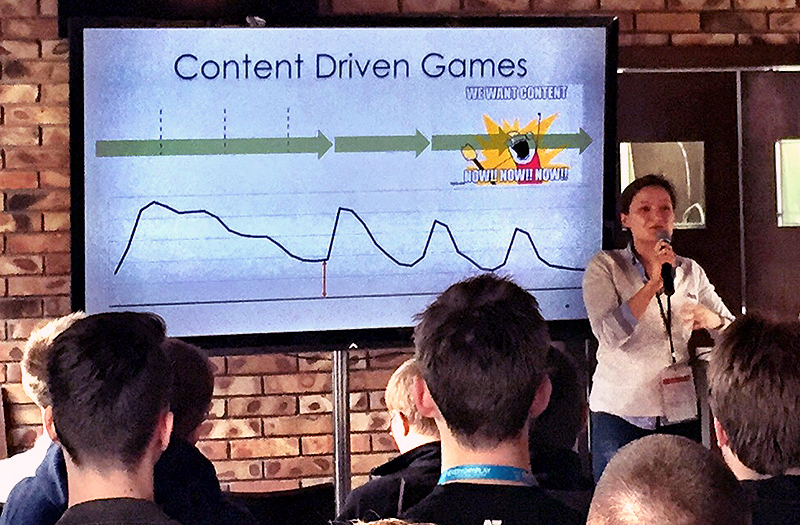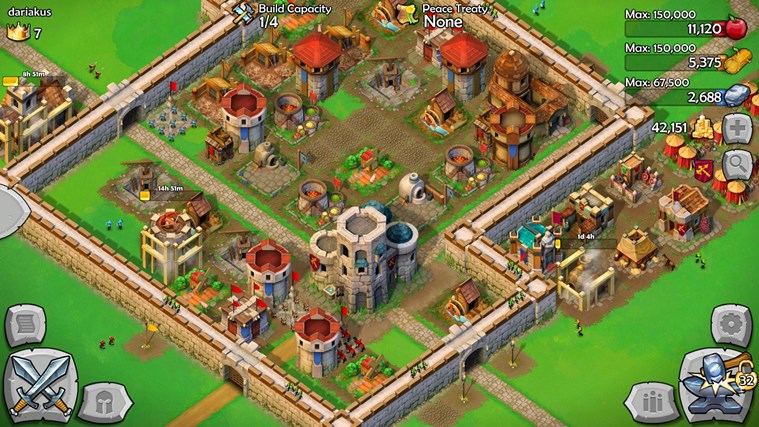Trending
Opinion: How will Project 2025 impact game developers?
The Heritage Foundation's manifesto for the possible next administration could do great harm to many, including large portions of the game development community.
What's the secret to successful free-to-play, and why will none of the major players willing to tell the rest of us? The reason, Keith Andrew argues, is that doing so would mean acknowledging that F2P is an entirely different beast to the paid model.

Welcome to the magical world of mobile, where the clever boys and girls at the world's most creative, ingenious studios have fathomed a way to make millions of dollars from games they don't even charge a penny for consumers to download. The industry has been revolutionised, all of its problems have been solved, and Apple's gated community ensures every developer gets an equal share of the ever expanding pie.
Or perhaps not. It's been especially easy for the mobile press to get wrapped up in the huge successes the industry has fostered since the App Store first launched in 2008, with the rise of free-to-play a couple of years later ensuring companies few people had heard of quickly become household names.
That's been the irony that's not been lost on many of the developers attempting to earn a living on iOS. What originally started as a way to breathe new life into the industry - with the world's big publishers stumbling and stalling during the iPhone's early years to get to grips with what was on offer – has now become a mirror image of the market it sought to usurp. Instead of the major players we've all become used to seeing dominate console and PC over the decades, mobile now has its own glitterati; King, Supercell and Zynga, for instance, all appear to have 'cracked' the formula. The success they have respectively amassed on smartphones is unprecedented, and the dominance they now enjoy well documented.
Nonetheless, the picture isn't quite as straightforward as it might first appear. Go to any games conference around the world where someone from one of these companies is speaking (typically about the successful implementation of free-to-play in profitable games) and you'll likely see a queue of people snaking out of the venue.
I remember at GDC 2013 in San Francisco watching in amazement as a the line of attendees waiting to get into see Tommy Palm, the then 'games guru' at King, took to the stage to unlock the secrets behind Candy Crush Saga. (It was a particularly dry day for me, there as a journalist sent to cover said talk, yet unable to enter said room despite the fact I'd joined the queue 25 minutes before it was due to kick off.)
Having seen Palm give what turned out to be similar talk months later, what he divulged – the 'secret' all those GDC attendees had been waiting for – had much in common with many of the other presentations given by those working at studios with a penchant for F2P: make a quality game with strong retention that keeps players loyal. The theory is, the more closely tied to your game a player is, the more likely they'll be to part with their cash.
What few of the major players talk about, however, is the mechanics they to exact that cash: the in-app purchase. It's a phrase that carries an awful lot of baggage despite being a relatively fresh addition to the gaming lexicon, yet – as was recently pointed out at the Digital Dragons conference in Kraków, Poland – far too many developers get fixated with how much they can charge and what for without thinking about the logical reasons as to why people would want to part with their cash.
The secret of the in-app purchase – and one you won't find all too many of the big boys espousing about, perhaps because of the negative connotations that come with the phrase – is that it has to be planned for before you've even begun working on the game itself.
"In a content driven game, your audience is like a marathon runner," said Grazyna Domanska, monetisation manager at Paris-based developer Kobojo, at the conference in Poland. "The people who are most engaged will consume your content quickest, and they'll get to the end first, but for a F2P game, if a player completes your game, that's the end of your product, that's the end of your revenue, and you can't ever allow that to happen.”
The end result of a theory such as this is that is that you need to keep the game ticking over with content and the ability to spend within that content forever, and this is not something that can be tagged on to a contained, premium game. What the F2P masters often seem reluctant to admit is that successful free releases are their own beast: they have to be constructed from start to finish, and are a very different proposition in terms of development.

Grazyna Domanska of Kobojo talks at Digital Dragons in May 2015
It's a sentiment perhaps best summed up by Adam Telfer, product lead at free-to-play and social games specialist Wooga in Berlin, back in February of this year:
“The traditional gaming space is clearly showing signs that its moving towards a digital future,” detailed Telfer. “To make this transition, game designs will need to change. In order to move to this model, commercial games will have to adjust their progression systems to focus on economies and currencies to gate and pace players.
“The pay-to-play vs free-to-play model is drastically different when it comes to design. Thus far many attempts haven’t worked. Either the designs copy far too much from current free-to-play models and leave the current base alienated, such as Age of Empires: Castle Siege by Microsoft. Or the designs are clearly a pay-to-play game at its core, and they fail to retain players long enough to generate revenue.”
As both Telfer and Domanska suggest, cracking this code is a two step process. First, you have to decide that you're developing a free-to-play game in the first place.
This is no small decision – it's less a case of weighing up whether you're comfortable with embracing F2P or not, and more a move to decide if you can come up with a compelling free-to-play structure. If you already have a rough idea in your head about a game you'd like to create that hasn't, from it's very birth, been conceived as a free-to-play release, then scrap it and move on. Retrofitting a game with the F2P model rarely works, even if said retrofitting takes during the game's development.
Secondly, you then have to formulate what parts of the game will be subject to the player parting with his or her cash and just why they'd want to in the first place. This is where analytics from any previous F2P games you've worked on can be key in determining what works and what doesn't. Are you going to employ an energy system? How many virtual currencies should you build in? What are you going to sell that will actually add to play in a meaningful way without unfairly impinging gamers who want to play for free?
“What I recommend is, sit down with your design team and list out all of the commodities in your game,” reasoned Domanska, speaking at Digital Dragons in Kraków. “Then you need to decide your currencies – two to three currencies are the best. Don't go with single currency as it's really hard to balance. Seriously, just don't do it. And when you do live events, you need to give people a real reason to engage with the event – you need to offer a 'Ferrari', if you like, so make a list of what you can offer.”
 Age of Empires: Castle Siege was an attempt to bring a Clash of Clans style game to Windows Phone
Age of Empires: Castle Siege was an attempt to bring a Clash of Clans style game to Windows Phone
None of this is easy, of course, and the biggest frustration is, all of these elements shift from game to game. There's no one-size-fits-all formula for making a great free-to-play game, and it's crucial that every game you offer comes with some form of originality. If every game plays like Clash of Clans, gamers will simply stop playing.
The cold, hard truth is, there is no universal answer as to just how to deploy the perfect in-app purchase, and no presentation by any of the major F2P players at any conference around the globe is ever going to give you a model that's guaranteed to work. However, in the years before F2P, were there ever any guarantees when it came to designing a paid game? Was creating a great game using the traditional models actually any easier? Weren't flops just as common, and true success just as scarce?
The one advantage, in fact, that we have with free-to-play games is that we now have the tools to monitor not just the number of people playing, but more crucially how they're playing. While converting a paid game to free-to-play post release is almost always a bad idea, it's still entirely possible to tweak a F2P based on player data post launch – in fact, you'll struggle to find a F2P release that hasn't altered in some form or other post release based on analytics the development team has trawled over.
Did your last live event not work? You'll know. Are those in-app purchases failing to entice players? You'll know. Is the game's core loop falling flat? You'll know. Analytics can't tell you how to fix all these problems, but you will know what's not working and, to a certain extent, you'll also be able to piece together just why. There is no silver bullet, no universal answer to your in-app purchase woes, but in the ever-shifting market that is mobile free-to-play, the more information you have, the closer you'll get to cracking your game's own individual code.
Key takeaways:
There is no 'one size fits all' solution for deploying in-app purchases, so don't look for a magic bullet
Free-to-play games have to be free-to-play games from their very conception - retrofitting at any stage rarely works
You need to come up with intelligent, compelling reasons for why anyone would want to pay for your IAPs
Sifting through your analytics should highlight what's going wrong with your game post release, even if it doesn't give you the solutions itself
Keith Andrew is an Analytics advisor at GameAnalytics. You can read more blog posts from the company here.
Read more about:
BlogsYou May Also Like